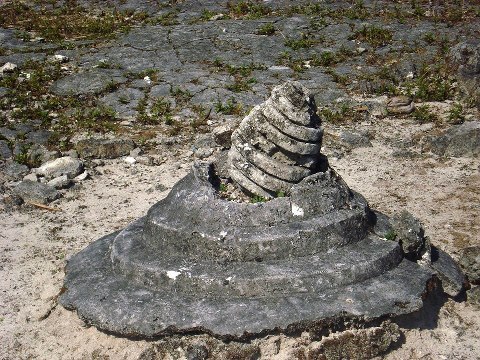Kaashidhoo Kuruhinna Tharaagandu is an
archaeological site 2–4 hours from Malé, in the island of Kaashidhoo
(Kaafu Atoll), Maldives. The site is a Buddhist Monastery and is
believed to have been used by pre-Islamic Maldivians dating back to
7th-8th century AD. The excavation work was done in various periods from
February 1996 through 1998.During this period, an area of 1,880m2 was
excavated, revea
ling 64 coral stone structures.For the vast majority, only the lower most parts have been preserved.

Kaashidhoo Kuruhinna Tharaagandu is situated just outside the houses of the village at Kaashidhoo in a plantation of coconut, papaya and banana trees. During the three excavation campaigns, an area of 1,880 square meters with 64 ruins was investigated. This is only a part of the original monastery where its total size is not known. Except for one. the structures uncovered were coarse coral stone with sand and stones. Square, rectangular, circular and semi-circular extensions arc different variations of shapes of the structures found. The sizes varied between one metre and 11.5 meters. The lowermost parts of the structures (30-40 Cm) had normally been preserved; the rest had been used as building material over the years. Numerous stones were collected during the excavations which were worked and profiled.
In a corner of a ruin, by the steps leading to it was a pit consisting of cowrie shells amounting to 62,000. These shells have been dated to AD 165-345 . Cowrie shells played an important role in the Buddhist culture and religion, Representatively as well as economically. Around AD 500, when cowrie shells spread to northern and central Europe, they were also mentioned as trading products from the Maldives, as shown in the archaeological finds in the region.
In another ruin, it is a 16-sided structure with a height of 1.3m and a diameter of 6m, with a platform at the top and a flight of stairs on the south side. This is one or the biggest and best preserved structures at the site.
In conclusion, this excavation proved that Buddhist culture was recognized in the Maldives in the first part of the first Millennium. Archaeological evidence proves that the ancient people who lived here, built large monuments, monasteries temples and dagobas, which were eventually destroyed in later centuries.
http://www.saarcculture.org/index.php?option=com_content&view=article&id=205

Kaashidhoo Kuruhinna Tharaagandu is situated just outside the houses of the village at Kaashidhoo in a plantation of coconut, papaya and banana trees. During the three excavation campaigns, an area of 1,880 square meters with 64 ruins was investigated. This is only a part of the original monastery where its total size is not known. Except for one. the structures uncovered were coarse coral stone with sand and stones. Square, rectangular, circular and semi-circular extensions arc different variations of shapes of the structures found. The sizes varied between one metre and 11.5 meters. The lowermost parts of the structures (30-40 Cm) had normally been preserved; the rest had been used as building material over the years. Numerous stones were collected during the excavations which were worked and profiled.
In a corner of a ruin, by the steps leading to it was a pit consisting of cowrie shells amounting to 62,000. These shells have been dated to AD 165-345 . Cowrie shells played an important role in the Buddhist culture and religion, Representatively as well as economically. Around AD 500, when cowrie shells spread to northern and central Europe, they were also mentioned as trading products from the Maldives, as shown in the archaeological finds in the region.
In another ruin, it is a 16-sided structure with a height of 1.3m and a diameter of 6m, with a platform at the top and a flight of stairs on the south side. This is one or the biggest and best preserved structures at the site.
In conclusion, this excavation proved that Buddhist culture was recognized in the Maldives in the first part of the first Millennium. Archaeological evidence proves that the ancient people who lived here, built large monuments, monasteries temples and dagobas, which were eventually destroyed in later centuries.
http://www.saarcculture.org/index.php?option=com_content&view=article&id=205
BetMGM Casino - JamBase
ReplyDeleteBetMGM 안양 출장마사지 Casino is a great place to make a quick and easy 울산광역 출장샵 deposit while enjoying your favourite casino 보령 출장마사지 games from the comfort of your home. 영천 출장마사지 We 제주 출장안마 do not